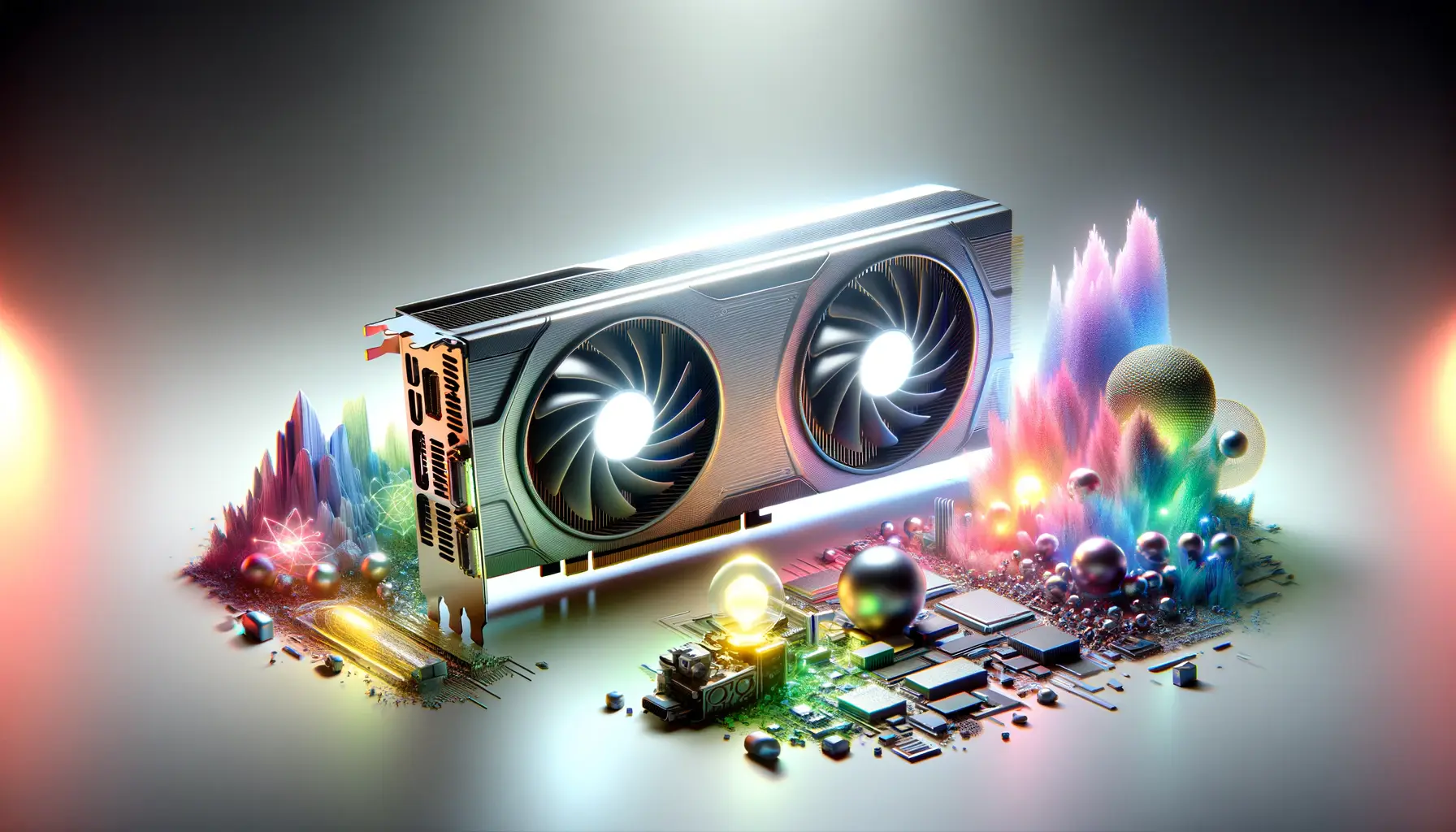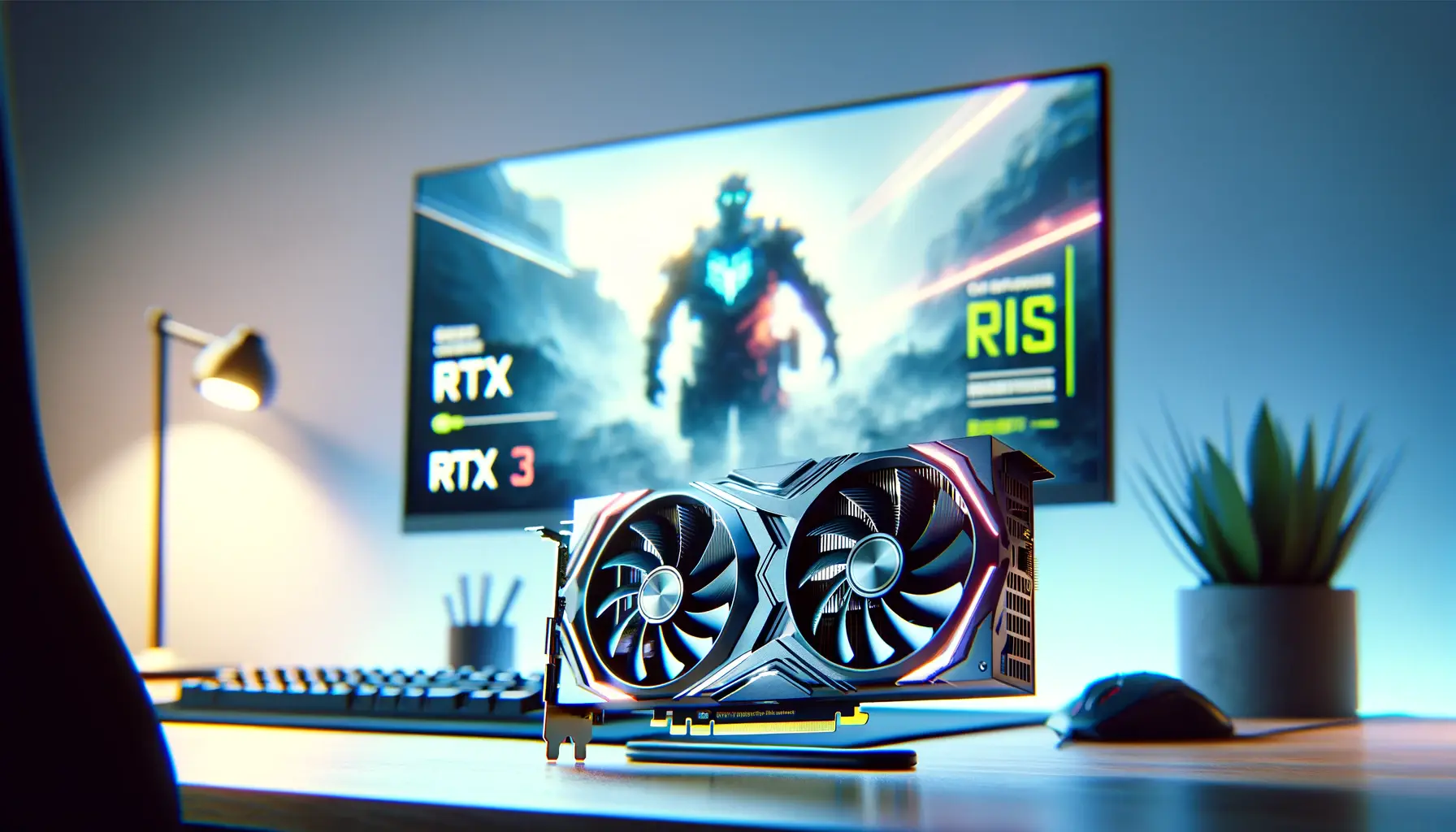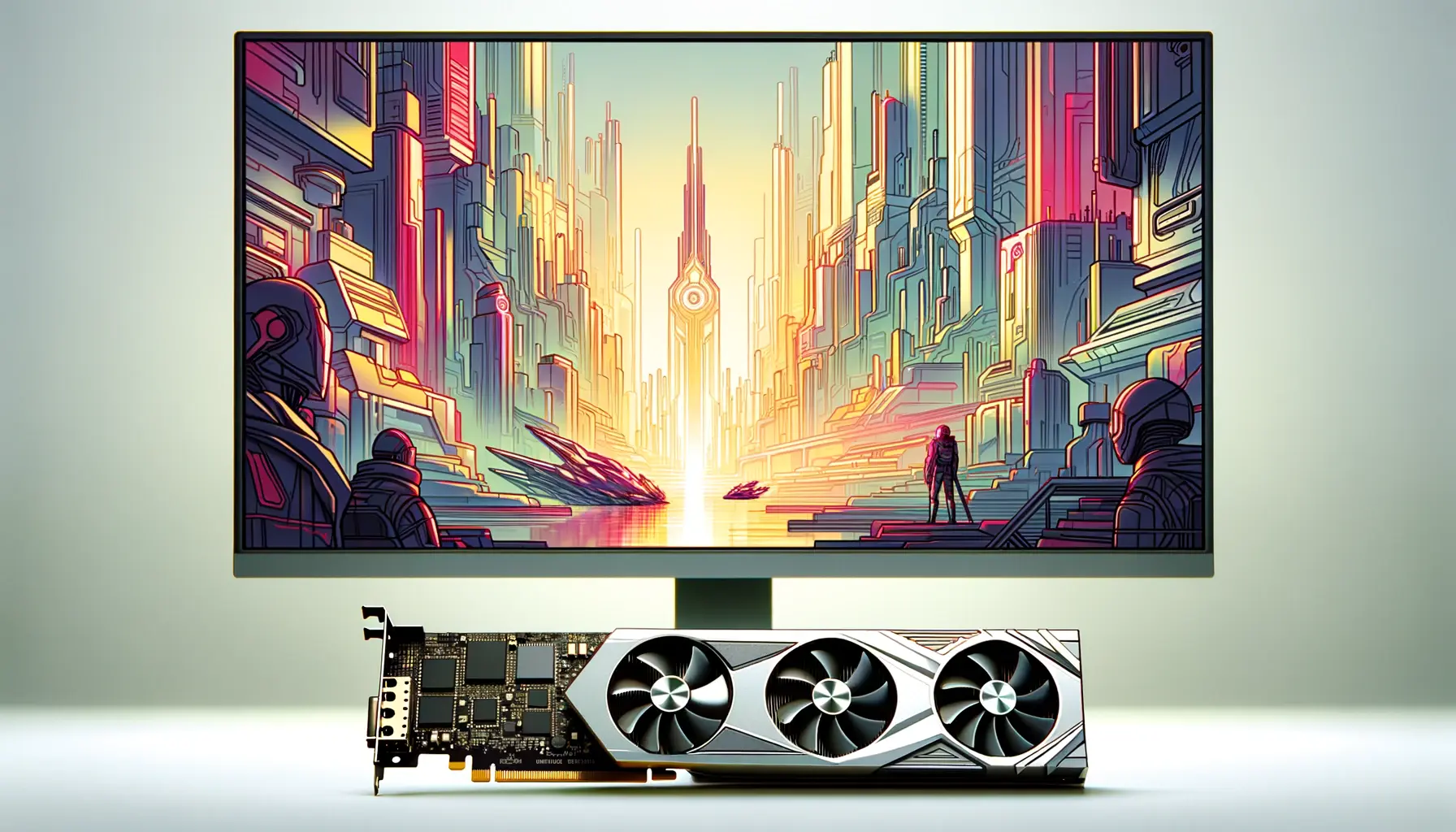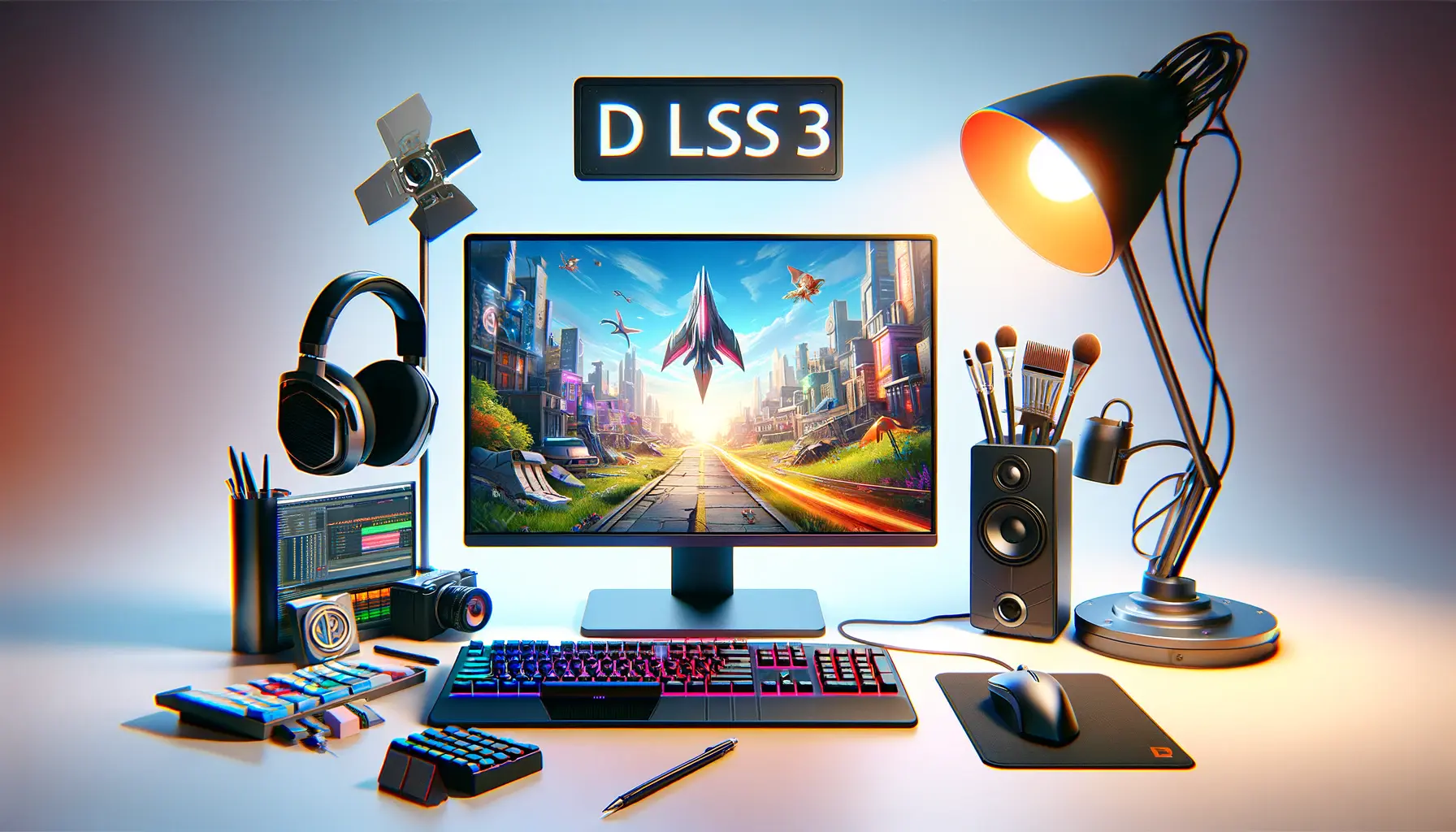The realm of gaming is perpetually on the cusp of technological advancements, with each leap aiming to immerse players deeper into virtual worlds.
Among these innovations, NVIDIA’s Deep Learning Super Sampling (DLSS) technology stands out, particularly its third iteration, DLSS 3.
This groundbreaking technology not only promises to revolutionize game aesthetics but also to redefine the gaming experience by leveraging artificial intelligence to enhance visuals and performance.
DLSS 3, developed by NVIDIA, is a testament to the power of AI in gaming.
It goes beyond its predecessors by not just improving frame rates but by significantly enhancing visual quality.
This technology uses advanced AI algorithms to upscale images in real-time, delivering crisp, high-resolution visuals without the traditional computational cost.
The result is a seamless gaming experience, with graphics that are more detailed and immersive, even on hardware that would otherwise struggle to maintain high performance with such demanding visuals.
- The Evolution of DLSS Technology
- DLSS 3’s Role in Gaming Performance
- DLSS 3 and Its Impact on Game Development
- Comparative Analysis of DLSS 3 with Previous Versions
- DLSS 3 in Action: Real-World Game Enhancements
- Challenges and Considerations in Implementing DLSS 3
- Future Directions of DLSS Technology
- Embracing the Future with DLSS 3
- DLSS 3 Visuals: Enhancing Game Aesthetics – FAQs
The Evolution of DLSS Technology
From DLSS 1.0 to DLSS 3.0
The journey of DLSS began with its first version, which introduced the concept of using deep learning to improve game rendering.
DLSS 1.0 was a significant step forward, but it was not without its flaws, including issues with image clarity and artifacting.
NVIDIA’s response was swift and effective, leading to the development of DLSS 2.0.
This version brought vast improvements in image quality and flexibility, allowing for a broader adoption across games and platforms.
It set the stage for DLSS 3, which has taken the technology to new heights by incorporating frame generation and AI-driven enhancements that push the boundaries of what’s possible in game visuals.
DLSS 3’s introduction of frame generation is a game-changer.
By interpolating frames, it can effectively double the perceived frame rate, making games run smoother than ever before.
This is particularly beneficial for fast-paced titles where every millisecond counts.
The AI-driven approach ensures that the added frames are not just filler but are of high quality and consistent with the game’s visual style.
DLSS 3’s AI algorithms are trained on a supercomputer, learning from high-resolution game footage to generate beautiful, sharp images in real-time.
Impact on Game Aesthetics
The impact of DLSS 3 on game aesthetics cannot be overstated.
By enabling higher resolutions and frame rates, it allows developers to create more detailed and expansive game worlds.
Textures are more refined, and environmental effects like lighting, shadows, and reflections are more realistic, contributing to a more immersive gaming experience.
For gamers, this means that titles previously limited by hardware capabilities can now be enjoyed in their full glory, with smooth performance and stunning visuals.
Moreover, DLSS 3’s efficiency opens up new possibilities for game developers.
Freed from some of the constraints of hardware performance, developers can focus on artistic and creative aspects of game design.
This could lead to more ambitious projects, with richer environments and more complex visual effects.
The technology not only enhances existing games but also paves the way for future titles to push the envelope of what’s visually and technically possible in gaming.
DLSS 3’s Role in Gaming Performance
The advent of DLSS 3 by NVIDIA has not only been a boon for game aesthetics but also a pivotal factor in enhancing gaming performance.
This section delves into how DLSS 3 optimizes performance, ensuring that games not only look better but run smoother on a wide range of hardware configurations.
At its core, DLSS 3 utilizes a unique blend of AI and machine learning to analyze and interpolate frames, effectively boosting the game’s frame rate without a significant increase in graphical processing unit (GPU) load.
This innovative approach to frame generation and upscaling allows for a more fluid gaming experience, particularly in titles that are graphically intensive.
Enhancing Frame Rates
The primary allure of DLSS 3 lies in its ability to dramatically enhance frame rates.
By generating additional frames through AI, DLSS 3 can double or even triple the frame rate of games, making for a smoother and more responsive gameplay experience.
This is particularly beneficial in fast-paced genres such as first-person shooters (FPS) and racing games, where every frame can make a difference in the heat of the moment.
- Frame Generation: DLSS 3’s frame generation technology predicts and adds new frames, reducing the workload on the GPU and maintaining high frame rates even in demanding scenes.
- AI Upscaling: Alongside frame generation, DLSS 3 upscales lower-resolution images to higher resolutions, ensuring that the visual fidelity is not compromised for performance.
Reducing Latency
Another significant advantage of DLSS 3 is its impact on reducing latency.
By optimizing the rendering pipeline and utilizing NVIDIA Reflex technology, DLSS 3 ensures that the input lag is minimized.
This results in a more responsive gaming experience, where player inputs are reflected on-screen with minimal delay.
- NVIDIA Reflex Integration: Reflex technology works in tandem with DLSS 3 to reduce system latency, offering a competitive edge in multiplayer and eSports titles.
- Improved Responsiveness: The combination of higher frame rates and reduced latency means that games feel more responsive, allowing players to react more quickly to in-game events.
DLSS 3’s impact on performance extends beyond just frame rates and latency. It also allows for higher resolution gaming on less powerful hardware, democratizing access to high-quality gaming experiences.
The integration of DLSS 3 into a game’s rendering pipeline represents a significant leap forward in gaming technology.
It not only enhances the visual quality but does so in a way that improves overall performance, making it a critical tool for both game developers and gamers alike.
As more titles adopt DLSS 3, its role in shaping the future of gaming continues to grow, promising a new era of high-performance, visually stunning gaming experiences.
DLSS 3 and Its Impact on Game Development
The introduction of NVIDIA’s DLSS 3 technology has not only transformed the gaming experience for players but also significantly impacted the game development process.
This technology enables developers to achieve a balance between stunning visuals and optimal performance, thereby redefining the boundaries of game design and development.
DLSS 3 offers a suite of tools that developers can leverage to enhance the visual quality of their games without compromising on performance.
This section explores how DLSS 3 is influencing game development practices and the potential it holds for the future of gaming.
Facilitating More Complex Visuals
One of the most immediate impacts of DLSS 3 on game development is the ability to incorporate more complex and detailed visuals into games.
With DLSS 3’s AI-driven upscaling and frame generation, developers can now push the envelope on graphics quality, knowing that the technology can maintain smooth performance even on less powerful hardware.
- Higher Detail Levels: Developers can include finer textures, more complex models, and advanced lighting effects, confident that DLSS 3 will upscale the visuals without a significant performance hit.
- Enhanced Environmental Effects: Effects such as ray tracing, which were previously too demanding for real-time rendering in complex scenes, can now be more widely implemented, thanks to DLSS 3’s efficiency.
Optimizing Game Performance
DLSS 3 also plays a crucial role in optimizing game performance.
By intelligently generating frames and upscaling from lower resolutions, it allows games to run at higher frame rates without requiring more powerful hardware.
This optimization is particularly crucial for maintaining immersion in VR games and ensuring competitive fairness in multiplayer titles.
- Scalability Across Platforms: DLSS 3 enables games to scale more effectively across different hardware platforms, from high-end gaming PCs to more modest setups, ensuring a broader audience can enjoy high-quality gaming experiences.
- Reduced Development Time: With DLSS 3 handling much of the heavy lifting for performance optimization, developers can allocate more resources towards creativity and innovation, potentially reducing development time and costs.
The adoption of DLSS 3 in game development not only enhances the visual and performance aspects of games but also encourages innovation in game design, allowing developers to explore new concepts and ideas without being limited by hardware constraints.
As DLSS 3 continues to gain traction in the gaming industry, its impact on game development is expected to deepen.
This technology not only offers a solution to the perennial challenge of balancing graphics quality with performance but also opens up new possibilities for creative expression and storytelling in games.
The future of game development, powered by AI and technologies like DLSS 3, promises to bring even more immersive and visually spectacular gaming experiences to players around the world.
Comparative Analysis of DLSS 3 with Previous Versions
The evolution of NVIDIA’s DLSS technology has been marked by significant milestones, with each version bringing improvements and new features to the gaming world.
DLSS 3, the latest iteration, stands as a testament to NVIDIA’s commitment to pushing the boundaries of gaming performance and visual fidelity.
This part of the article delves into a comparative analysis of DLSS 3 with its predecessors, highlighting the advancements and the impact on gaming experiences.
Understanding the differences between DLSS 3 and earlier versions is crucial for appreciating the technological leap it represents.
From its inception, DLSS aimed to use AI to enhance gaming visuals and performance, but each version has approached this goal with increasing sophistication.
DLSS 1.0 to DLSS 2.0: The Foundation
DLSS 1.0 introduced the concept of using deep learning to upscale lower-resolution images in real-time, allowing games to run at higher frame rates without compromising on visual quality.
However, it faced criticism for issues like blurriness and artifacts.
DLSS 2.0 addressed these concerns by introducing a more flexible and efficient architecture, significantly improving image quality and offering better performance across a wider range of games and resolutions.
- DLSS 1.0 was groundbreaking but had limitations in image clarity and artifacting.
- DLSS 2.0 improved upon these issues with a new architecture, offering greater flexibility and enhanced image quality.
DLSS 2.0 to DLSS 3.0: A Quantum Leap
DLSS 3 represents a quantum leap over its predecessors by incorporating AI-driven frame generation, a feature absent in earlier versions.
This addition allows DLSS 3 to not only upscale images but also to create intermediate frames, effectively boosting the game’s frame rate.
This results in smoother gameplay and allows for higher settings in graphically intensive games without the need for more powerful hardware.
- Frame Generation: DLSS 3 introduces AI-driven frame generation, significantly boosting frame rates by creating additional frames.
- Enhanced Performance: With DLSS 3, games can achieve higher frame rates and resolutions, making for a smoother and more immersive gaming experience.
DLSS 3’s introduction of frame generation technology marks a significant advancement in AI-driven gaming, setting a new standard for performance and visual quality.
The progression from DLSS 1.0 through DLSS 2.0 to DLSS 3 has been characterized by NVIDIA’s continuous efforts to refine and enhance the technology.
Each version has built upon the successes of its predecessors, with DLSS 3 standing as the pinnacle of these efforts.
By comparing DLSS 3 with previous versions, it’s clear that NVIDIA has not only addressed the limitations of earlier iterations but has also expanded the possibilities of what can be achieved with AI in gaming.
The result is a technology that significantly enhances both the visual quality and performance of games, paving the way for future innovations in the gaming industry.
DLSS 3 in Action: Real-World Game Enhancements
The true measure of DLSS 3’s impact lies in its application within real-world gaming scenarios.
Across various titles, from blockbuster hits to indie gems, DLSS 3 has demonstrated its ability to transform the gaming experience.
This section explores how DLSS 3 has been implemented in games, showcasing the tangible benefits it brings to both gamers and developers.
By examining specific case studies, we can observe the enhancements DLSS 3 offers in terms of visual fidelity, performance, and overall gameplay experience.
These examples highlight the technology’s versatility and effectiveness across different genres and graphical settings.
Case Study: Cyberpunk 2077
Cyberpunk 2077, with its vast open world and intricate detail, serves as a prime example of DLSS 3’s capabilities.
Upon implementing DLSS 3, players noted a significant improvement in frame rates, particularly in densely populated areas of Night City.
This enhancement allowed for smoother gameplay and reduced latency, making the immersive experience of exploring the dystopian metropolis even more engaging.
- Improved Frame Rates: DLSS 3 enabled Cyberpunk 2077 to run at higher frame rates without compromising on the game’s rich visual detail.
- Enhanced Visuals: The technology also allowed for the use of higher graphical settings, including ray tracing, without a substantial performance hit.
Case Study: Control
Control, known for its visually stunning and physics-heavy gameplay, also benefited from the integration of DLSS 3.
The technology’s frame generation and upscaling capabilities allowed the game to maintain high performance during intense combat sequences and complex visual effects, ensuring a seamless gaming experience.
- Seamless Performance: DLSS 3 helped maintain a consistent frame rate during graphically demanding scenes, enhancing the fluidity of gameplay.
- Visual Clarity: The upscaling feature of DLSS 3 ensured that the game’s artistic style was preserved, even while running at higher resolutions.
DLSS 3’s impact extends beyond individual titles, setting a new benchmark for what is achievable in terms of game performance and visual quality.
The implementation of DLSS 3 in games like Cyberpunk 2077 and Control showcases the technology’s ability to elevate the gaming experience.
By enhancing visual fidelity and performance, DLSS 3 allows players to enjoy games at their highest potential, regardless of their hardware’s limitations.
These real-world applications of DLSS 3 not only demonstrate its effectiveness but also hint at the future possibilities for game development and design.
As more developers adopt DLSS 3, the gaming landscape is set to evolve, offering even more immersive and visually stunning experiences to gamers around the globe.
Challenges and Considerations in Implementing DLSS 3
While DLSS 3 offers significant advantages in terms of enhancing game aesthetics and performance, its implementation is not without challenges.
Developers must navigate a variety of considerations to fully leverage the technology’s capabilities.
This part of the article explores the hurdles and critical factors associated with integrating DLSS 3 into game development processes.
Understanding these challenges is essential for both developers looking to adopt DLSS 3 and gamers curious about the technology’s application in their favorite titles.
It sheds light on the complexities behind the seamless gaming experiences enabled by DLSS 3.
Technical Integration
Integrating DLSS 3 into a game’s rendering pipeline requires a deep understanding of the technology and its interaction with the game’s existing graphics engine.
Developers must work closely with NVIDIA to ensure that DLSS 3 functions correctly within their specific game architecture.
This process can be time-consuming and requires a level of technical expertise that may not be immediately available to all development teams.
- Compatibility with Game Engines: Ensuring DLSS 3 works seamlessly with various game engines is a key challenge for developers.
- Optimization for Different Hardware: Developers must also consider how DLSS 3’s performance enhancements scale across different hardware configurations to ensure a consistent gaming experience for all players.
Quality Assurance and Testing
Quality assurance plays a crucial role in the successful implementation of DLSS 3.
Extensive testing is required to fine-tune the technology’s performance and ensure that it delivers the intended visual enhancements without introducing artifacts or other visual anomalies.
This testing process can be resource-intensive, requiring multiple iterations to achieve the desired outcome.
- Visual Fidelity: Maintaining the game’s visual integrity while utilizing DLSS 3’s upscaling and frame generation features is paramount.
- Performance Across Resolutions: Testing is also necessary to verify that DLSS 3 provides consistent performance benefits across various resolutions and settings.
A common misconception is that DLSS 3 can be simply ‘plugged into’ a game without extensive customization and testing. In reality, its successful integration is the result of careful planning and collaboration between developers and NVIDIA.
The challenges associated with implementing DLSS 3 underscore the technology’s complexity and the effort required to harness its full potential.
Despite these hurdles, the benefits of DLSS 3—enhanced visuals, improved performance, and a more immersive gaming experience—make it a worthwhile endeavor for game developers.
As the gaming industry continues to evolve, the lessons learned from integrating DLSS 3 will undoubtedly contribute to the development of even more advanced technologies in the future.
Future Directions of DLSS Technology
The continuous evolution of Deep Learning Super Sampling (DLSS) technology, culminating in the release of DLSS 3, marks a significant milestone in gaming and graphics technology.
However, the journey doesn’t end here.
The future of DLSS holds promising advancements and potential applications that could further revolutionize the gaming industry.
This section explores the prospective directions DLSS technology might take, considering the current technological landscape and emerging trends in gaming.
As DLSS technology matures, its integration into game development and the broader graphics industry is expected to deepen, bringing about new possibilities for both developers and gamers.
Broader Adoption and Accessibility
One of the immediate future directions for DLSS technology is its broader adoption across more games and platforms.
As developers become more familiar with the benefits and integration process of DLSS, we can expect to see an increase in the number of titles supporting DLSS 3.
This widespread adoption will not only enhance the gaming experience across a variety of genres but also make high-quality gaming more accessible to players with less powerful hardware.
- Expansion to More Titles: Increasing the library of games that support DLSS 3 will allow more gamers to experience its benefits.
- Integration into Game Development Tools: Incorporating DLSS technology directly into popular game development engines could streamline its adoption, making it easier for developers to implement.
Advancements in AI and Machine Learning
The core of DLSS technology is its use of AI and machine learning algorithms to enhance gaming visuals and performance.
As advancements in these fields continue, we can anticipate future versions of DLSS to offer even more sophisticated image upscaling and frame generation capabilities.
This could lead to even higher quality visuals and smoother performance, further blurring the line between game graphics and reality.
- Improved Image Quality: Future iterations of DLSS could provide even more realistic and detailed visuals, with fewer artifacts and improved consistency across different scenes.
- Enhanced Frame Generation: As AI models become more advanced, the frame generation process could become more efficient, offering higher frame rates without compromising image quality.
The potential integration of DLSS technology with emerging gaming technologies such as virtual reality (VR) and augmented reality (AR) could open up new avenues for immersive gaming experiences, leveraging DLSS to deliver high-fidelity visuals in real-time VR and AR environments.
The future of DLSS technology is bright, with its potential extending beyond traditional gaming into new realms of digital entertainment and content creation.
As NVIDIA and the gaming community continue to explore and expand the capabilities of DLSS, we can look forward to a new era of gaming where visual quality and performance are no longer constraints but avenues for creativity and innovation.
The advancements in DLSS technology will not only redefine gaming aesthetics but also push the boundaries of what’s possible in interactive entertainment.
Embracing the Future with DLSS 3
The journey through the evolution, implementation, and potential future of DLSS 3 technology underscores its transformative impact on the gaming industry.
As we’ve explored the nuances of DLSS 3, from its inception to its current state and beyond, it’s clear that this technology is not just a temporary advancement but a cornerstone for future gaming experiences.
The integration of DLSS 3 into games has already begun to reshape the landscape of gaming visuals and performance, offering a glimpse into a future where the lines between digital and reality are increasingly blurred.
The Path Forward
As DLSS 3 continues to evolve, its adoption will likely become more widespread, setting new standards for what gamers expect in terms of visual fidelity and smooth performance.
The technology’s ability to deliver high-resolution, high-frame-rate gaming without the need for prohibitively expensive hardware is a game-changer, making premium gaming experiences more accessible to a broader audience.
This democratization of high-quality gaming is perhaps one of DLSS 3’s most significant contributions to the industry.
Challenges and Opportunities
Despite the clear advantages of DLSS 3, the challenges in its implementation remind us that progress often comes with hurdles.
However, these challenges also present opportunities for growth and innovation.
As developers become more adept at integrating DLSS 3 into their games, we can expect to see even more creative uses of the technology, pushing the boundaries of what’s possible in game design and development.
- Increased realism in game visuals, enhancing the immersive experience for players.
- Improved performance across a wider range of hardware, making high-end gaming more accessible.
- Continued innovation in AI and machine learning, driving future advancements in gaming technology.
In conclusion, DLSS 3 stands as a testament to the power of AI in enhancing game aesthetics and performance.
Its impact extends beyond mere technical improvements, offering new creative possibilities for developers and more immersive, accessible gaming experiences for players.
As we look to the future, the continued evolution of DLSS technology promises to keep pushing the envelope, ensuring that the best of gaming is yet to come.
The journey of DLSS 3 is far from over; it is just beginning, and its full potential is only starting to be realized.
DLSS 3 Visuals: Enhancing Game Aesthetics – FAQs
Explore the most common inquiries about DLSS 3 and its impact on gaming aesthetics and performance.
DLSS 3 utilizes AI to upscale games, improving frame rates and visual quality without heavy hardware demands, making games look sharper and run smoother.
No, DLSS 3 is exclusive to NVIDIA’s GeForce RTX 40 Series GPUs, leveraging their advanced AI capabilities for optimal performance.
DLSS 3 introduces frame generation and NVIDIA Reflex, significantly boosting frame rates and reducing latency compared to earlier versions.
By generating additional frames and upscaling images, DLSS 3 allows games to run at higher resolutions and frame rates, enhancing smoothness and detail.
DLSS 3 requires game developers to integrate the technology, so it’s currently available in select titles that support it.
DLSS 3 aims to preserve the original artistic intent, enhancing clarity and detail while maintaining the game’s visual style.
Yes, through the integration of NVIDIA Reflex, DLSS 3 reduces system latency, making games more responsive to player inputs.
Future DLSS versions may offer even more sophisticated AI upscaling and frame generation, broadening support for more games and hardware.












